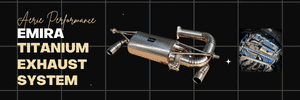The Emira's brake specs have been confirmed by Scott Walker (UK Sales Manager) here in this video (~16:20 mark) from the recent Concorde event:
- Front: 4 piston AP Racing calipers w/ 370mm (14.6") drilled rotors
- Rear: 4 piston AP Racing calipers w/ 350mm (13.7") drilled rotors
Last edited:




